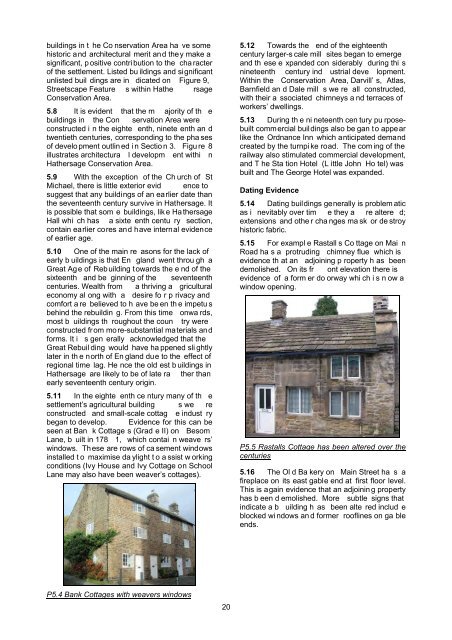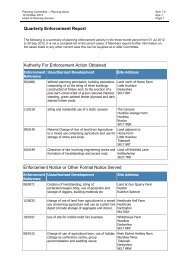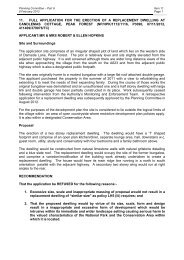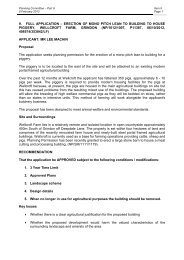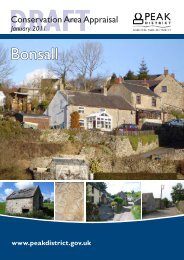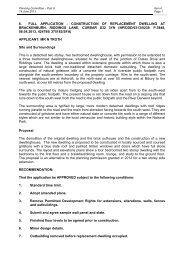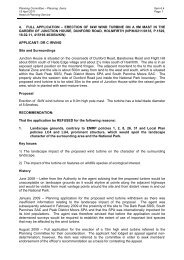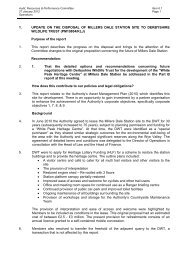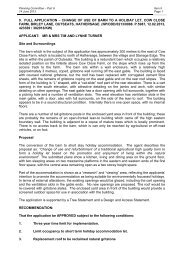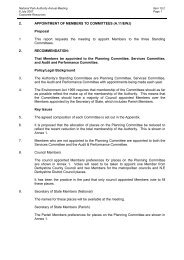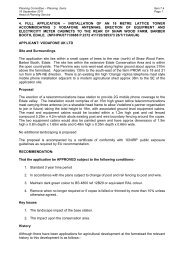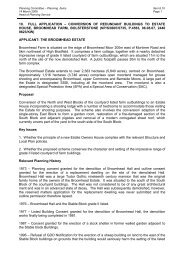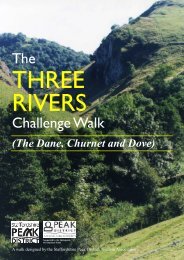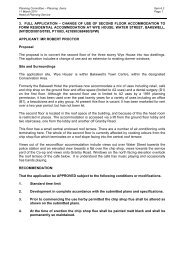Appendix - Peak District National Park Authority
Appendix - Peak District National Park Authority
Appendix - Peak District National Park Authority
Create successful ePaper yourself
Turn your PDF publications into a flip-book with our unique Google optimized e-Paper software.
uildings in t he Co nservation Area ha ve somehistoric and architectural merit and they make asignificant, p ositive contri bution to the cha racterof the settlement. Listed bu ildings and significantunlisted buil dings are in dicated on Figure 9,Streetscape Feature s within Hathe rsageConservation Area.5.8 It is evident that the m ajority of th ebuildings in the Con servation Area wereconstructed i n the eighte enth, ninete enth an dtwentieth centuries, corresponding to the pha sesof develo pment outlin ed i n Sectio n 3. Figu re 8illustrates architectura l developm ent withi nHathersage Conservation Area.5.9 With the exception of the Ch urch of StMichael, there is little exterior evid ence tosuggest that any buildings of an earlier date thanthe seventeenth century survive in Hathersage. Itis possible that som e buildings, lik e Ha thersageHall whi ch has a sixte enth centu ry section,contain earlier cores and have internal evidenceof earlier age.5.10 One of the main re asons for the lack ofearly b uildings is that En gland went throu gh aGreat Age of Rebuilding towards the e nd of thesixteenth and be ginning of the seventeenthcenturies. Wealth from a thriving a griculturaleconomy al ong with a desire fo r p rivacy andcomfort a re believed to h ave be en th e impetu sbehind the rebuildin g. From this time onwa rds,most b uildings th roughout the coun try wereconstructed from more-substantial materials andforms. It i s gen erally acknowledged that theGreat Rebuil ding would have ha ppened sli ghtlylater in th e north of En gland due to the effect ofregional time lag. He nce the old est b uildings inHathersage are likely to be of late ra ther thanearly seventeenth century origin.5.11 In the eighte enth ce ntury many of th esettlement’s agricultural building s we reconstructed and small-scale cottag e indust rybegan to develop. Evidence for this can beseen at Ban k Cottage s (Grad e II) on BesomLane, b uilt in 178 1, which contai n weave rs’windows. These are rows of ca sement windowsinstalled t o maximise da ylight t o a ssist w orkingconditions (Ivy House and Ivy Cottage on SchoolLane may also have been weaver’s cottages).5.12 Towards the end of the eighteenthcentury larger-s cale mill sites began to emergeand th ese e xpanded con siderably during thi snineteenth century ind ustrial deve lopment.Within the Conservation Area, Darvill’ s, Atlas,Barnfield an d Dale mill s we re all constructed,with their a ssociated chimneys a nd terraces ofworkers’ dwellings.5.13 During th e ni neteenth cen tury pu rposebuiltcommercial buildings also be gan to appearlike the Ordnance Inn which anticipated demandcreated by the turnpi ke road. The com ing of therailway also stimulated commercial development,and T he Sta tion Hotel (L ittle John Ho tel) wasbuilt and The George Hotel was expanded.Dating Evidence5.14 Dating buildings generally is problem aticas i nevitably over tim e they a re altere d;extensions and othe r cha nges ma sk or de stroyhistoric fabric.5.15 For exampl e Rastall s Co ttage on Mai nRoad ha s a protruding chimney flue which isevidence th at an adjoining p roperty h as beendemolished. On its fr ont elevation there isevidence of a form er do orway whi ch i s n ow awindow opening.P5.5 Rastalls Cottage has been altered over thecenturies5.16 The Ol d Ba kery on Main Street ha s afireplace on its east gable end at first floor level.This is again evidence that an adjoinin g propertyhas b een d emolished. More subtle signs thatindicate a b uilding h as been alte red includ eblocked wi ndows an d former rooflines on ga bleends.P5.4 Bank Cottages with weavers windows20


